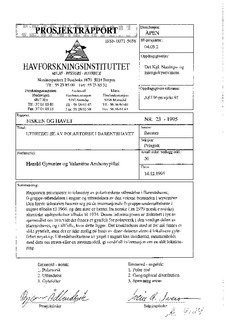| dc.description.abstract | This report gives, and sums up, information about the geographical distribution of polar cod in
the Barents Sea, useful when investigating the existence and Bocation of a possible spawning area
in the western parts of the Sea. Only information available at the Institute of Marine Research
in Bergen is included, and only the two sources of information most relevant to the question are
included, viz. the distribution of fingerlings in August and that of the adult stock in September.
These sources contains long time series of data; the 0-group distribution dates back to 1966 and
that of the adult stock to 1974.
Based on this information, it is difficult to reach a conclusion about a possible spawning area in
the western parts of the Barents Sea. The geographical distribution of adult fish in autumn gives
evidence for such a spawning area, but is also compatible with the hypothesis that the known
spawning area in the south-eastern Barents Sea is the only one in this area. The distribution of
polar cod 0-group in August points, however, to the fact that spawning must take place in two
separate areas, since most years there are two separate concentrations of fingerlings. Since these
data are sampled in August, and spawning probably takes place in early spring, the distribution
of 0-group polar cod cannot done show the location of a western spawning area. Combined with
a current model these data should, however, give valuable information about the location of
spawning.NORSK SAMMENDRAG:I forbindelse med arbeidet med å kartlegge polartorskens gytefelter i Barentshavet, er det i denne
rapporten samlet informasjon om polartorskens utbredelse i Barentshavet som kan kaste lys over
denne problemstillingen. Kun informasjon tilgjengelig ved Havforskningsinstituttet er tatt med,
og bare de to datakildene som synes å gi den mest relevante informasjonen om polartorskens
mulige gytefelter; nemlig yngelutbredelsen i august og utbredelsen av den voksne bestanden i
September. For disse to datakildene foreligger lange tidsserier, yngelutbredelsen er kartlagt
tilbake til 1966, og den voksne bestanden tilbake til 1974.
Det synes vanskelig, på grunnlag av denne informasjonen alene, å trekke konklusjoner angående
et eventuelt gytefelt i det vestlige Barentshav. Basert på utbredelsen av voksen polartorsk om
høsten synes det rimelig å anta at det må finnes et gytefelt sør eller øst av Svalbard, men
fordelingen er også forenlig med en teori om at det kjente gytefeltet i den sørøstlige delen av
Barentshavet er det eneste. Ut fra yngelutbredelsen i august synes det klart at det må være to
separate gytefelter, da det de fleste år er to separate fordelinger av yngel. Da disse dataene er
samlet inn i august, og gytingen trolig foregår tidlig om våren, kan ikke yngelutbredelsen alene
angi hvor gytefeltet ligger. Kombinert med en strømmodell skulle imidlertid disse dataene kunne
gi verdifull informasjon om lokaliseringen av et gytefelt i vest. | en |
